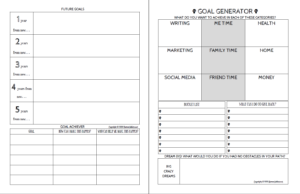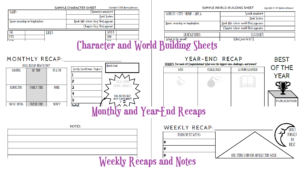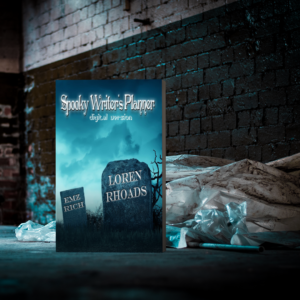from Wily Writer Loren Rhoads
I am a planner junkie. For years, I kept searching for a system that would help me organize all the information I need, track all my submissions, make space for my to-do lists, and keep my calendar. I would hear one of my writer friends rave about a system they were excited to try or see an ad that promised to get me organized and snatch it up. I ended up with a cupboard full of half-used planners.

Loren Rhoads
Last year, when all my anchors were suddenly gone—no more writing in the cafe after dropping my kid off at school, no more writing in the car before I picked her up in the afternoon—I really struggled to focus and get anything done. What saved me was my planner stash. I took the planners apart and pulled out all my favorite charts: what were my goals for the year? What writing projects had I started and drifted away from? What markets did I want to pitch articles to? When were my favorite magazines open for story submissions?
sample page from Spooky Writer’s Planner, click to view larger
Armed with that information, I made a master to-do list. Everything went on it, no matter how big or small. Which social media did I enjoy using and what was my theory behind my presence there? What were my goals for my newsletter and how could I better connect with my readers there? Since I couldn’t attend the conventions I’d looked forward to, how else could I get my books into the hands of readers?
Once I finally had EVERYTHING noted down, I could see that it was clearly too much for one person to accomplish RIGHT NOW. I used my planner sheets to pull out the little things that I could finish easily. Once I crossed those off my list, I got a jolt of pride that carried me forward to tackle bigger projects.
I made writing dates with friends over Zoom. A writer I knew set up a Tuesday morning chat for her writer friends. I joined Shut Up & Write sessions. I organized Happy Hours and went to writer’s group meetings online. Slowly, my weeks took on some structure. I needed a calendar to keep track of when everything was happening.
I’d published a novel in February (then saw all the conventions I’d planned to attend get postponed or canceled), so with my planner’s help, I managed to put together a blog tour and list of reviewers. After I attended the Bram Stoker Awards online, I was inspired to assemble a collection of my short stories, using what I’d learned from the first blog tour to promote it. Cross that goal off my list!
sample clips from Spooky Writer’s Planner, click to view larger
Inspired by my planner, I also did some major reorganization projects in my office, emptying all my file drawers and consolidating my research. I (finally!) assembled a binder of all the contracts I’d signed over my writing career. I made another binder of unfinished stories, so I could see the work ahead of me.
Having projects waiting for my attention made it much easier to deal with the discovery that the nonfiction book I’d been researching didn’t match the book the publisher wanted, one I was unable to write because of a previous contractual obligation. In another time, I would have been spun by the rejection. I would have been lost for months. Instead, because I’d been doing all this work on goals, I quickly shifted gears and began work on what became the third book I published last year. It’s no exaggeration to say that my cobbled-together planner was a lifesaver.
The upshot of this is: there are many planners for writers out there. Some focus on logging your daily word count. Others track the business aspects of being a writer: your income and expenses. Still others concentrate on calculating your available writing time and how to make best use of it. Some combine inspiration with goal-setting. Finding the right planner for yourself may take a couple of tries, but if you find a planner that supports the kind of writer you are and the work you want to do, it can change your life. It is definitely worth the effort.
Check out the Spooky Writer’s Planner that Loren designed with the help of artist EMZ Rich, available through the Wily Writers Gift Shop. Spooky Writer’s Planner

